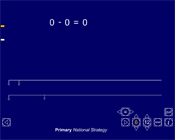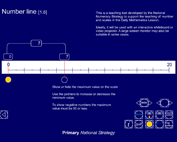Consolidation and practice
These resources are to support children in guided or independent work. Roll over the highlighted resources for a description.
Difference

This interactive teaching program (ITP) is an ICT-based tool to support the exploration of number. Difference ITP allows the child or teacher to compare two rows of beads and to analyse the calculations they can represent. It can be used to promote the language of addition and subtraction. The ITP operates as a series of animations which show how the rows of beads can be represented by two number lines and then as a single number line with the difference indicated by a 'jump'.
Number line

This interactive teaching program (ITP) is an ICT-based tool to support the exploration of number. Number line ITP allows the child or teacher to display a range of numbers from minus 50 up to 500. Children can estimate a number on the number line, explore the concept of difference between two given numbers and demonstrate their calculation strategies.
Confirming learning
Use probing questions and prompts such as:
- Eleven is three more than eight. Make a sentence using the same numbers and the words 'less than'.
- Seven biscuits from a packet have been eaten. There are eight left. How many biscuits were in the packet?
- The difference between 57 and 92 is 35. Write as many calculations as you can that use these three numbers.
- 17 + 47 = 64
Give three other calculations that use the same numbers.
- Give me an example of when it would be useful to know an inverse fact.
 less than 12. How much greater is 12 than five?
less than 12. How much greater is 12 than five? − 7 = 15
− 7 = 15 Calculating
Calculating


